Truck Opel Blitz: Wehrmacht workhorse
Truck Opel Blitz is recognized as the best three-ton truck of the Wehrmacht. At the same time, it is the only truck that was produced throughout the war until the defeat of Germany. This truck was produced on a specially built for this purpose car factory of Opel in Brandenburg - “an exemplary national socialist enterprise”. Since 1944, Daimler-Benz has joined the production of this truck. Of the three-ton Opel Blitz trucks that were produced by 129 795, approximately 100 thousands were delivered directly to the Wehrmacht and the SS troops, while the rest were used in the defense industries of Nazi Germany.
Opel Blitz is considered to be one of the best and most popular German trucks. Its design was standard, while differing in reliability and relative simplicity. On the basis of this truck was built a large number of various special purpose machines. In addition, its modifications were produced, equipped with engines of different power. Produced as all-wheel drive model of the car. In order to save scarce metal, at the very end of the war, the Germans began to produce trucks with wooden ersatz cabins.
On the basis of the Opel Blitz truck, many special cars were built - ambulances, workshops, mobile radio stations, buses, fire trucks, etc. Often this chassis was also used to house small-caliber anti-aircraft guns. The bodies of most Opel Blitz trucks had the appearance of a platform with wooden boards and an awning installed, but trucks were also equipped with metal body-wagons.
The German company Opel enjoyed special respect from the Nazi government, which in the second half of the 20th century 30 quickly became a leader in terms of automobile production and became Germany’s largest manufacturer of army trucks of the Blitz series.
In March 1929, the American company General Motors acquired a stake in 80% in Adam Opel. At the same time, Opel was the first company in Germany to establish a bank and an insurance company to finance car sales on credit. In 1931, the American company expanded its stake in Adam Opel to full 100%. At the same time, Opel received 33,3 million dollars for both deals, turning into 100% subsidiary of General Motors. Curiously, this company actively funded the Nazi Party in the 1933 parliamentary elections of the year. The company employed about 13 thousands of people who collected up to 500 cars and 6000 bikes every day.
As a result of the inflow of foreign investment in the middle of the 1930-s, Opel held the second wave of restructuring and reconstruction of production. In total, 190 days in Brandenburg built a new assembly plant of the company, and also created a network of German enterprises - subcontractors who were engaged in the supply of components. Huge investments made it possible to increase the number of the company's staff by almost 40%. In 1936, Opel already produced the 120 923 vehicle per year, becoming the largest car manufacturer in Europe.
In the 1937 year, after long years, during which Opel was also the largest manufacturer of bicycles, the company decided to stop their production, transferring it to NSU. It was decided to concentrate fully on the production of automotive vehicles. In 1940, the millionth car was produced in a German company.
Since the American leadership of GM, which owned the company at the time, was opposed to the release of military products, by the beginning of the war Opel Blitz was late, until the 1940, the factory only collected a civilian version of the truck. However, in 1940, Opel was nationalized by the Nazis. At the same time in October 1940, the assembly of passenger cars was completely stopped. From 1940, the Opel Blitz truck began to arrive in the army. During the Second World War, the company's enterprises supplied about half of the total number of trucks in the German army.
Opel Blitz truck
As a result, the unified 3-ton truck "Blitz" of models "3,6-36S" (4х2) and "3,6-6700А" (4-4) received the greatest popularity and spread among the troops. These cars were produced from 1937 year in large numbers - about 95 thousands of copies. These were durable and easy-to-operate vehicles with a tonnage of 3,3 and 3,1 tons, respectively. The machines were distinguished by the presence of closed all-metal cabins, a high heatsink with a vertical lining and an emblem in the form of a lightning stroke, as well as stamped rounded wings.
These trucks were equipped with a solid spar frame consisting of U-shaped steel profiles. Also installed on the machine 6-cylinder engine volume 3,6 liter, he was borrowed from the passenger car Opel Admiral. Also on the truck was mounted a dry single-plate clutch, a new 5-speed gearbox, hydraulic brake, threaded axles on longitudinal semi-elliptical springs and rear dual wheels. Cars of both types received tires of the same size 7,25-20 with a developed tread pattern. Only two of these trucks were released in approximately 70 and 25 thousand series, respectively. At the same time, in the 1944-1945, the Daimler-Benz concern produced even more 3,5 thousands of Blitz rear-wheel drive trucks equipped with a simplified cab under the Mercedes-Benz index L701.
The basic rear-wheel drive truck model “3,6-36S” (Blitz-S) had a gross weight of 5800 kg and was produced from 1937 to 1944 year. The car had a wheelbase 3600 mm, and its curb weight was 2500 kg. The car was supplied with one fuel tank with a capacity of 82 liter and was adapted for towing a two-ton trailer. From 1940, parallel to the factories, Opel produced a four-wheel drive version under the designation "3,6-6700А" (Blitz-A), which was equipped with an additional two-stage transfer case and a wheelbase shortened to 3450 mm. In addition, the car differed slightly grown gauge and greater capacity of the fuel tank - 92 liters. The curb weight of the all-wheel drive version was 3350 kg. The maximum allowable weight when driving on the highway - 6450 kg, on the ground - 5700 kg. The truck could travel at speeds up to 90 km / h on the highway, and fuel consumption, depending on the traffic condition, was equal to 25-40 liters per 100 km, the power reserve was 230-320 km.
The fact that the carburetor six-cylinder in-line engine was installed on the Opel Blitz from the Opel Admiral car with a displacement of 3626 cube. see, it was common practice for those years. At 3120 rpm, this engine produced the 73,5 hp, which coincided in power with that of the Soviet ZIS-5, but the volume of the German engine was less. The engine crankcase was aluminum, and the cylinder head was made from gray iron. For every 100 km of run, the car spent 26 liters on asphalt and 35 liters on primer. The maximum range on the highway was 320 km.
The main advantage of the German truck was its high speed. On a good road, the “Lightning” could reach 90 km / h. The reason for such a good indicator for a truck of those years was the use in the main gear of the same gear ratio (equal to 43 / 10) as on the Opel Admiral automobile. However, this decision led to the fact that the Blitz did not cope well with towing heavy trailers, and the use of the trailer on the roads was completely ruled out.
The compression ratio was also related to the "light vehicle" value - 6 units, which required the use of only first-grade gasoline. For this reason, the use of captured gasoline on the Eastern Front was almost completely excluded. Because of this, in January 1942, in Germany, began to produce modifications with a reduced degree of compression in the engine. Thus, it was adapted to use 56 gasoline, and the gear ratio in the main gear was also increased. In the course of the changes, the engine power decreased only to 68 hp, and the maximum speed on the highway fell to 80 km / h. In order for the car to maintain the same power reserve, it was equipped with a 92-liter fuel tank. Fuel consumption at the same time increased to 30 liters on the highway and to 40 liters on dirt roads.
Opel Blitz based machines
The Opel Blitz 3-ton class trucks were used in almost all the fascist German military formations and performed all the military functions of cargo transportation, towing light artillery pieces, carrying infantry, carrying special superstructures. Various models of wood-metal and wooden bodies with different heights of sides, with awnings and with benches, numerous variants of rectangular model wagons or special structures with various components were installed on the trucks. Fuel tankers, tanks, fire trucks, gas generators, etc. were created on this chassis. Cars for SS units were equipped with mostly closed all-metal bodies for special purposes.
The German company "Miesen" installed on the standard Blitz chassis rounded sanitary bodies, which were intended to transport the wounded or to accommodate field laboratories and operating rooms. In the midst of the war, the company based on truck data produced a number of simple army multipurpose fire trucks. The base was a typical car pump LF15 on the rear-wheel drive chassis, equipped with a simplified closed wood-metal body with a double cab. At the rear was a water pump with 1500 performance l / min. The TLF15 fire tanker truck was already installed on an all-wheel drive base and was equipped with an openly located water tank with a volume of 2000 liters.
A variant of the basic rear-wheel drive version of the car were two cars with an extended base and 3,5 ton-carrying capacity - the Opel Blitz "3,6-42" and "3,6-47", which had wheelbases in 4200 and 4650 mm, respectively. Gross vehicle weight was 5,7 and 6,1 tons. These cars are also equipped with a variety of options on-board bodies, special superstructures and equipment, vans. These trucks have not received wide distribution. The Wehrmacht used them mainly for the installation of closed bodies with a double cabin, they also put fire-fighting equipment and water pumps Koebe. In the flatbed trucks Blitz 3,6-47 usually installed machine-gun or cannon systems with a supply of ammunition.
The most famous performance of the Blitz 3,6-47 truck chassis was the army bus W39, which had a full metal body made by Ludewig (Ludwig). The capacity of the bus was 30-32 seats. From 1939 to 1944, the year 2880 of such buses was released. Opel Blitz W39 buses were used to transport Wehrmacht officers, calculating armored vehicles, which were delivered along the highway on trailers. They were also used as ambulances, staff posts, printing presses, mobile sound stations, etc. All of these options could develop on the highway the same speed as the basic version of the truck, and their average fuel consumption was 30 liters per 100 km.
In 1942-1944, Opel also produced 3,6 thousand semi-tracked 36-ton SSM (Sd.Kfz.4) Maultier (Mul) series XXUMUM-2S chassis on its 3-19S chassis. On these trucks, a lightweight tracked propulsion unit from the British carden-Loyd wedge-shoes was used. Germany bought the license for its production from Great Britain before the outbreak of war. “Mules” were equipped with four disk support rollers on a lever-spring balanced suspension, as well as a steering device with a mechanical system for changing the speed of rewinding of the tracks, which allowed the tractor to perform more sharp turns. When using only the front steering wheels, the turning radius was equal to 15 meters, and with a slowdown of one of the thrusters - 225 meters. The ground clearance of the car has grown from 270 to XNUMX mm.
In terms of performance, the Opel semi-tracked truck was the most successful option in the Maultier series, it occupied an intermediate position between similar vehicles of Klöckner-Deutz Magirus and Ford. Gross vehicle weight was 5930 kg, fuel consumption - 50 liters per 100 km. In this case, the truck tractor could reach speeds of no more than 38 km / h. The disadvantages of the car called the increased load on the transmission, low speed, which was artificially limited due to the rapid wear of propulsion elements and, oddly enough, poor permeability. Of the total 2130 numbers manufactured, such half-tracked trucks were sent to the Eastern Front.
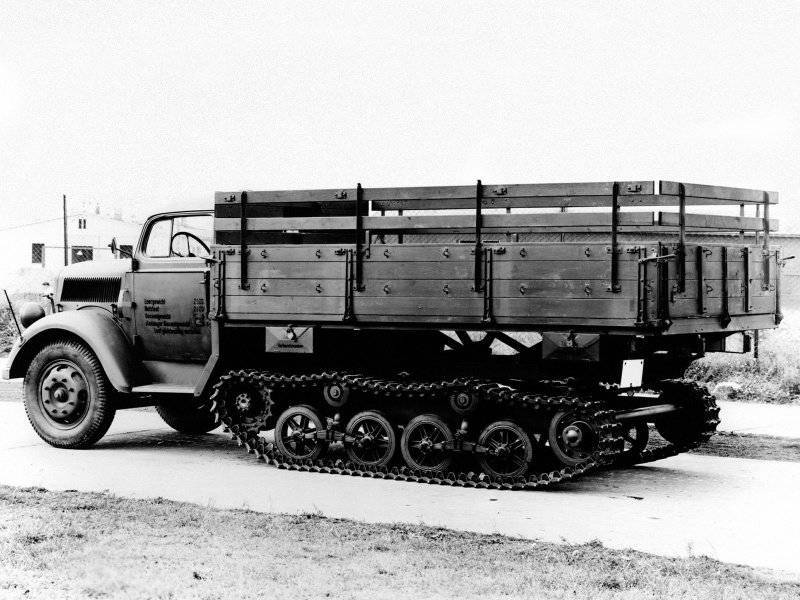
Already at the height of the war, an 3,6 launcher Sd.Kfz.36 / 300, the first German self-propelled salvo-fire systems, was assembled on an 4-1S / SSM semi-armored chassis with an anti-aircraft gun or a searchlight. They were equipped with a package of 10 tubular rails designed to launch missiles caliber 158,5 mm. The maximum firing range was 6,9 km. The Germans tried to oppose these machines to the Soviet "Katyushas". Partially armored chassis could also be used as ammunition conveyors, but all such constructions were slow-moving and too heavy.
In the summer of 1944, as a result of the bombing of the Allied forces, both of Opel’s main plants were seriously destroyed. The production of 3-ton trucks had to be transferred to the Daimler-Benz plant. After the war, the surviving equipment from Brandenburg was taken to the Soviet Union. And the company Opel again with the American help was able to restore its production, the release of the famous Opel Blitz trucks was continued.
Information sources:
http://voenteh.com/voennye-avtomobili/germaniya/gruzoviki-kommercheskogo-tipa/opel.html
http://retrotruck.ru/museum/cars-wehrmacht/191
http://www.tehnikapobedy.ru/opel.htm
http://drittereich.info/modules.php?file=viewtopic&name=Forums&t=1879
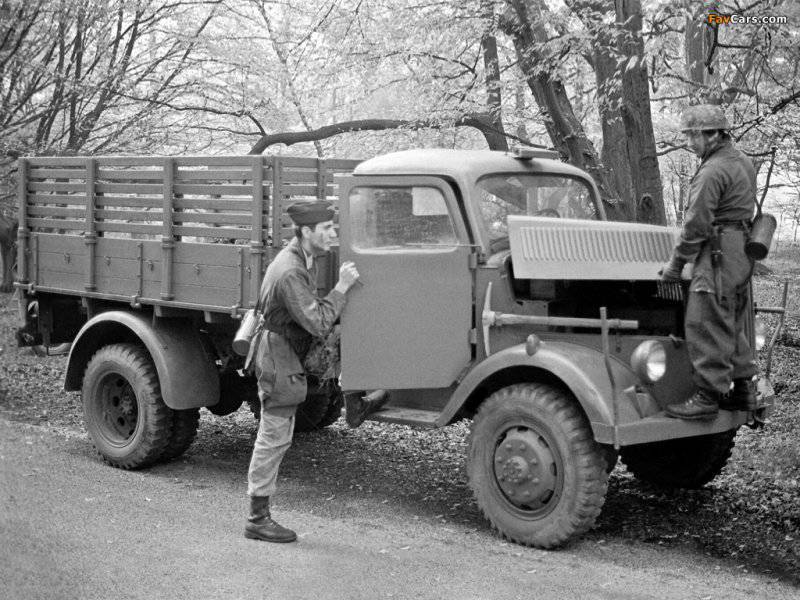
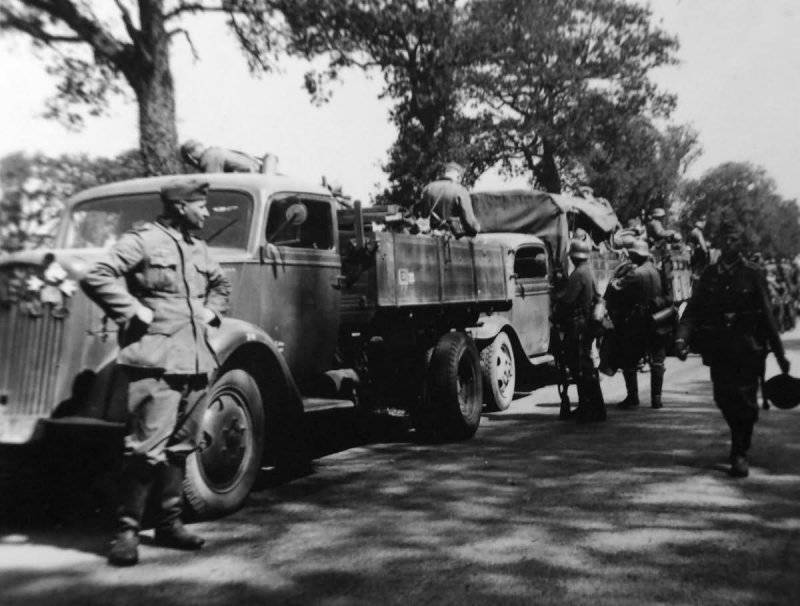
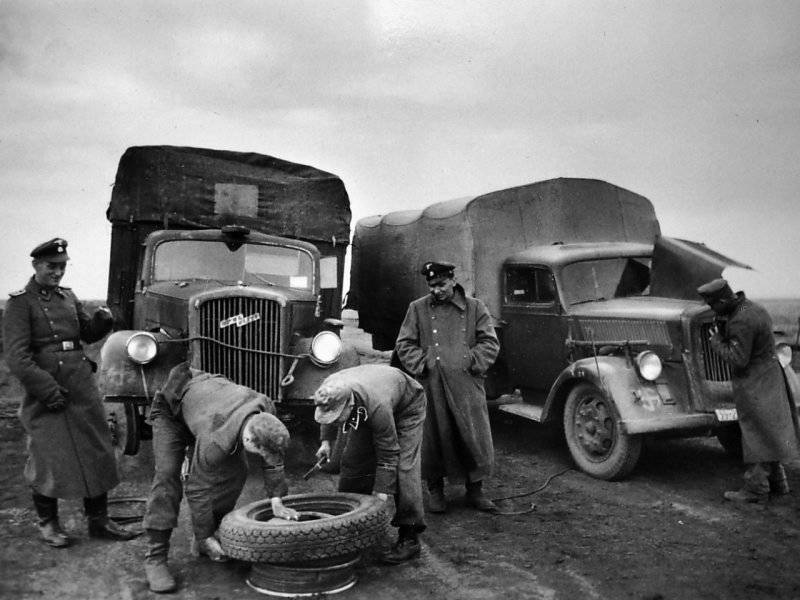
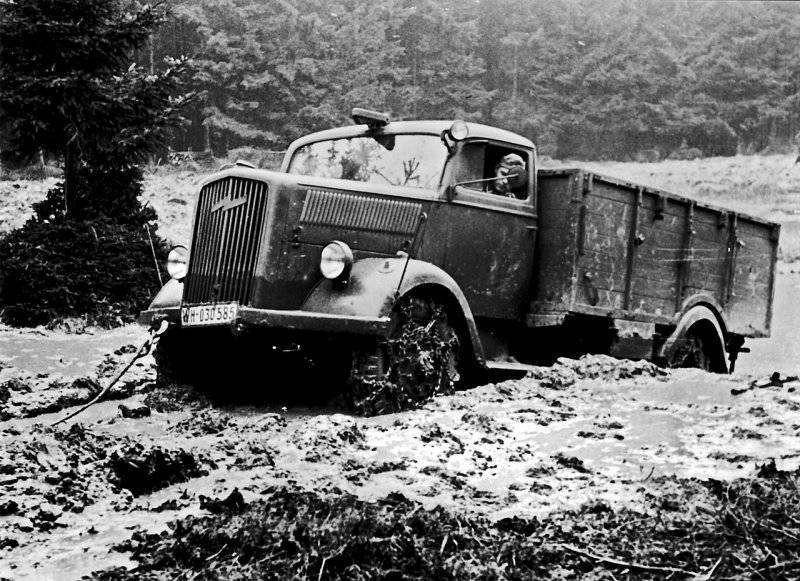
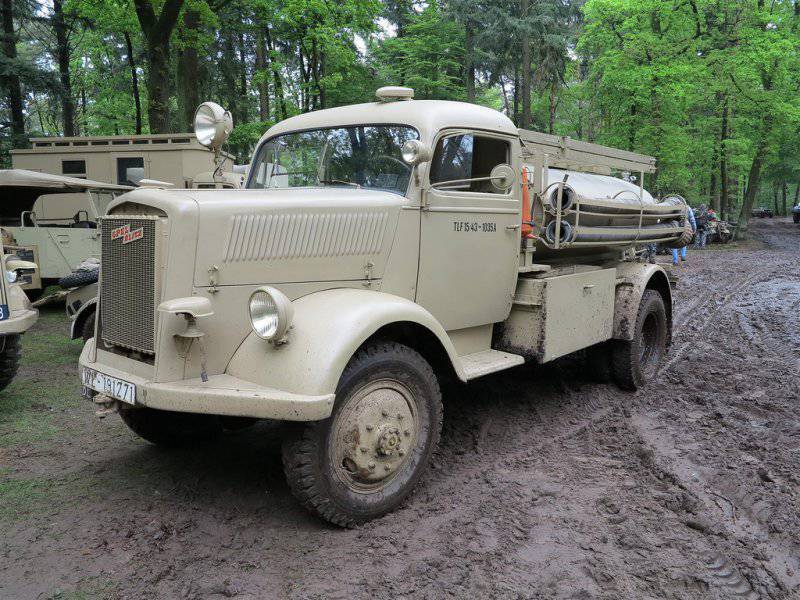
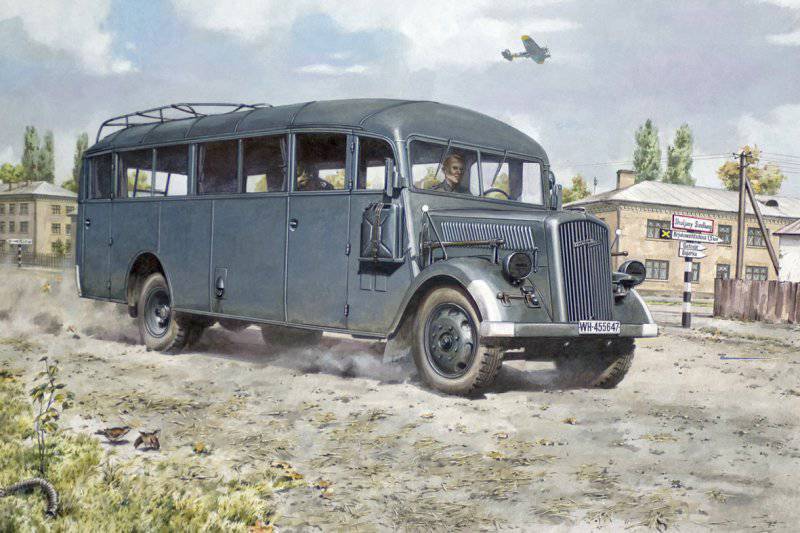
Information